Spain
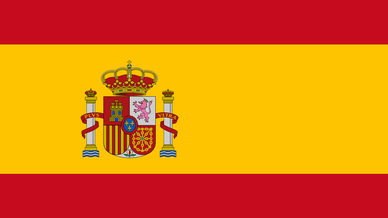
National flag of Spain
“Plus ultra!” or “Further beyond!” is the motto chosen by Spain, the country where everything is ineffably beautiful: 8,000 km of luxurious beaches, mountains, orange groves, and smiling and friendly people…
This fourth-largest European country is situated almost on the entire Iberian Peninsula. However, the Spanish lands are not only here.

General Information
As the echoes of glorious times of mighty royal Madrid, Spain also includes the Canary and the Balearic Islands and the African exclaves of Ceuta and Melilla. Besides, there are several sovereign territories on the Mediterranean coast of Africa.
Historical Background
As a state, Spain appeared in 1479 due to the dynastic marriage of King Ferdinand II and Isabella I of Castile. That was the inception of uniting the estranged Spanish lands.
The country had undergone several complicated milestones before. During the Roman and Visigothic rules, the Muslim era, and Reconquista, the lands of the Iberian Peninsula repeatedly passed from one ruler to another. Even the religion changed when Muslim armies conquered the territory.
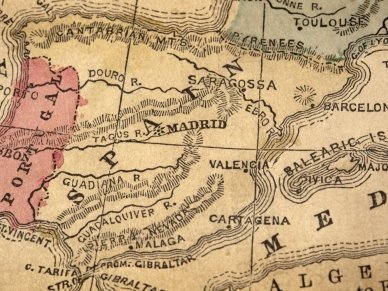
Spain on an ancient historical map
The long-lasting 700-year war against Muslim rule ended in 1492 with the victory of the Spanish and Portuguese Christians.
This year is considered the anchor point in the history of the Spanish Empire that sent its ships to conquer new lands at that time. The most successful was Christopher Columbus. A courageous navigator discovered the North American continent and opened it to the world. However, at first, he believed he had found the Orient.
Columbus was awarded the title of Dom and a range of other privileges for his merits. However, they were withdrawn later and then returned.
The first voyage was followed by three more. Ships had priests, statesmen, and labourers on board and were heading to new Spanish lands to found the colonies there.
The holds of ships were full of cows, sheep, pigs, and sacks of vegetable and fruit seeds. The preparation was thorough in order to settle, organise the daily life of colonists as soon as possible, and begin land reclamation.
Being critically ill, Christopher Columbus managed to extend the empire at the expense of his discoveries: the Antilles, Jamaica, the Virgin Islands, Cuba, and some other territories.
Columbus died in 1506 in Seville. His remains knew no peace for several centuries after the death. First, they were moved to Hispaniola (modern Haiti), then - to Cuba, and only in the 19th century, Seville became the final resting place of a great navigator. The grave of the legendary explorer is in the city’s cathedral.
The conquering of the northern and southern American lands continued. The Spanish Empire became the possessor of vast territories around the world. That was the first European state to conduct large-scale territorial and religious colonization.
The people of Mexico, Chile, Peru, the Philippines, and the other parts of the American continent were converted into Catholicism.
That was the golden era of Habsburg Spain, lasting till the beginning of the 18th century. The death of the last Spanish emperor became the moment so much awaited by Philippe, Duke of Anjou (the main heir of astounding wealth), Holy Roman Emperor Leopold, and other monarchs in the world.
The thirty-year War of the Spanish Succession began and ended with Spain being defeated. Philippe, Duke of Anjou, became the king of the weakened empire. France, England, Holland, and frenemies and closest relatives - the Austrian Habsburgs - obtained the lands.
Nonetheless, that was how the fall of the once-mighty empire began. In the 19th century in North and South America, the national liberation movement against Spanish rule gained momentum.
In the 1920s, the king’s authority in Spain was so weak that he relinquished power. General Miguel Primo de Rivera established a military dictatorship.
The rule of military men was not long-lasting. In 1930, the General left the country, and a year later, King Alfonso XIII did the same. Then there was a short period of total anarchy that ended with radicalization. The country became a republic being a monarchy from its earliest days.
Two years later, Nationalist General Francisco Franko came to power after the bloody civil war and established a harsher dictatorship. All political parties were forbidden, and the Falange supporting the new dictator was considered legal.
In 1947, Caudillo ordered to restore the monarchy. However, it was only a formality because the throne was empty till Franco’s death in 1975. After that, Juan Carlos I became the new king. It was time when the country cleared off the fascist dictatorship and commenced democratic transformations and reforms.
Spain has been an EU member since 1986. It is a country with a well-developed economy and a prevailing sector of high technology agriculture. However, north and south regions develop differently. The unemployment rate is higher in the south. The northern part is the centre of industrial manufacturing.
Separatist movements in the autonomous communities of the Basque Country and Catalonia have been adding some more troubles.
Geography and Climate
Spain borders France, Andorra, Portugal, Gibraltar, and African Morocco. The distance to the latter is just nine kilometres. The country is also bordered by the Atlantic Ocean and the Mediterranean Sea. It is about 300 km to get to the coast from the central regions.
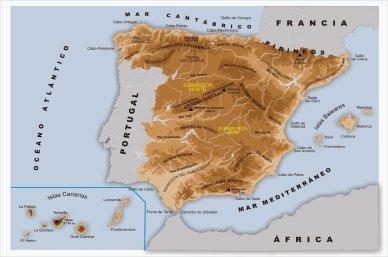
Geographic map. Spain.
Spain is a mountainous country: 90% of the territory constitutes mountains and highlands.
Climate is warm. That is why Spain is regarded as the warmest country in Europe: at least 260 days during the year are sunny. Summers are dry and hot. The temperature may reach +40°C, but norther regions are colder: temperatures range from +25°C to +28°C. Winters are warm and mild, not colder than -10°C or -12°C. Sometimes, it may be a bit freezing in the northwest.
Language, Population, and Currency
The population of Spain is around 46 million people. The official language is Spanish, but the languages of the indigenous populations like Basque, Galician, Aranese, and Catalan are also officially used in the autonomous communities.
Many migrants from the whole world live in Spain and already constitute 15% of the general population. Newcomers are attracted by the benign climate, perfect ecology, soft legislation, and excellent business opportunities.
The euro replaced the Spanish peseta and became the official currency after Spain joined the European Union.

Euro currency
A visa is needed to enter the country for a stay longer than 90 days.
Directions
Travelling to Spain is possible in many ways. Undoubtedly, the most popular option is to travel by plane, particularly for people from other continents.
Spain has a sea connection with the UK, Morocco, Algeria, and Italy. So tourists may feel free to choose a ferry to get to the country.

Traveling in Spain
International train network enables travellers to choose railway as one of the ways to arrive in Spain.
Travelling by bus and car are also very convenient options preferred by people from the neighbouring countries.

Accommodation
The high season at beach resorts in Spain begins in May and ends in October. So everyone who is going to visit this country in summer should take it into account. The prices of hotel rooms and suits reach their highest point.
Tourists flow in the other months too because everybody has their own aim of coming to Spain. Not always the main goal is to spend a holiday at the beach. Spanish mountain ski resorts are also a common thing among the fans of skiing thrill. That is why the resorts like Sierra Nevada, La Pinilla, and Valdesqui are packed with tourists between the middle of December and the middle of April. During this period, prices are rocketing.
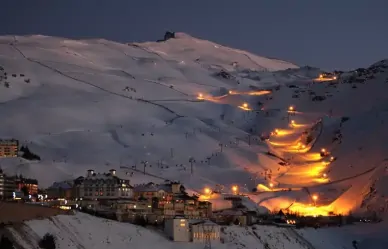
Sierra Nevada, Spain
Spain in spring is the lushness of greenery and flowers, the heady fragrance of blooming almond trees, and the time of spectacular festivals. Tourists come here to see dazzling performances and take part in various fests. For example, the Falles is the ninots (Spanish for ‘dolls’) festival traditionally held in March in Valencia. However, those willing to feel the atmosphere should find a hotel a month in advance. The thing is that people book the rooms at a rate of knots.
The hospitality industry in Spain is well-developed. Tourists are offered an extensive range of options that vary by preference and cost. That may be an ordinary bed in a hostel or a luxurious penthouse in the most expensive hotels.
However, if to compare the Spanish prices with other European countries fancied by travellers, a holiday in Spain is not going to be cheap.
Below are examples of budget-friendly hostels, boarding houses, and hotels:
- Pensión Azahar is a two-star boarding house in Sevilla, particularly good for family rest. The rooms have air-conditioning, bathrooms, hairdryers, TV sets, and other facilities. The pension is situated in the historical part of Sevilla, not far from Alcázar and the Cathedral.
- Hotel Ramos is a one-star hotel in Silleda. The rooms are designed and furnished in a plain way. They are clean and cosy, with bathrooms and showers. Breakfasts and Wi-Fi are free.
- Stardust House is a nice hostel in Las Palmas de Gran Canaria situated in the centre of old town not far from the bus station. The rooms are plain but clean. The cuisine is also good. Wi-Fi access is free of charge.
- CH Murallas II is a budget-friendly hotel in Madrid located a 15-minute drive from the Prado Museum. The rooms are plain, clean, and have bathrooms and air-conditioning. The hotel staff are friendly.
- Rodamon Barcelona is a two-star hostel in Barcelona. There are separate and shared stylishly designed rooms with comfortable beds and air conditioning. Showers and toilets are shared. Wi-Fi access is free of charge.
Those who plan a long-term stay in Spain, for example, with an aim of looking for a job, should search for an apartment. Specialized websites like https://www.idealista.com/en/ offer many rental options at affordable prices.
Places to See
To feel the soul of this magnificent country, you must definitely see its architecture, museums, national parks, corrida, and flamenco. If bullfighting is a spectacle predominantly for those strong in spirit, the other things are must-see.
There are no bland places in Spain. Each locality has its history, style, and attractions to be remembered forever.
Madrid
The Spanish capital was founded more than a thousand years ago. Initially, it was a small settlement that surrounded the fortress. The Muslim Emir Muhammad I ordered to construct it for protection from invasions of the kingdoms of León and Castile.
The Muslim rule ended with the victory of the Spanish in Reconquista, a long-lasting war between Christians and Muslims. Then Madrid started developing dynamically as a new cultural and political centre of the Kingdom. It became the capital city in the middle of the 16th century during the rule of King Phillip II.
At present, Madrid is the centre where numerous architectural monuments of the Middle Ages are concentrated. Once, they were designed and constructed by the best architects of Europe.
Royal Palace of Madrid is one of the most visited places in the Spanish capital. It is so huge that the endless labyrinths of corridors and passages contain around 2,000 rooms. However, tourists are allowed to see only fifty. But this incredible luxury of royal suites is enough to take your breath away.
Antique furnishing, expensive fabric drapes, stucco molding, decorations with gold plating and rare wood species, carpets, exquisite tableware, paintings, and weapon collections earn genuine admiration.

Royal Palace of Madrid
The Prado Museum is an old adversary of the Louvre in Paris and the State Hermitage Museum in Saint Petersburg by the number of exhibits and visitors. The Prado is included in the top ten most known museums in Europe.
The Museum also contains complete collections of such Spanish artists like de Goya, Velázquez, Murillo, and El Greco. There are the masterpieces of great Italians like Titian, Caravaggio, Bosch, and Rafael and riveting sculptures and exponents of decorative arts from antiquity to the 17th - 18th centuries (tables, consoles, and vases of different periods).
The opening hours are Monday to Saturday from 10 a.m. to 8 p.m. On Sundays and holidays, the museum closes at 7 p.m.
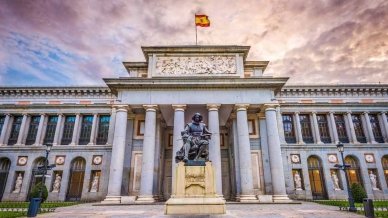
The Prado Museum
Puerta del Sol, or the Gate of the Sun, is the most known square in Madrid. Here you may see the Statue of the Bear and the Strawberry Tree - the symbol of the Spanish capital - and the Statue of King Carlos III, a successful reformer who revived Madrid from the decay.
In the capital of Spain, there is much to see on every corner. You will be dazzled with the magnificent parks of Casa de Campo and Buen Retiro, the city mayor’s residence, which used to be one of the royal palaces on Plaza de Cibeles, and numerous museums.
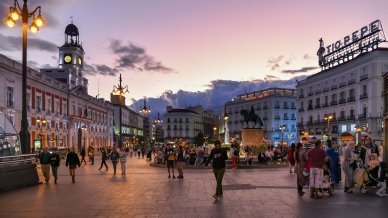
Puerta del Sol (the Gate of the Sun)
Barcelona
The capital of Catalonia is humorously called Ciutat Comtal (“The City of Counts”) by the Catalans.
It has been in the top five of any rating of the world’s most beautiful cities.
The Old City, its Gothic Quarter, La Ribera, and El Raval attract the particular attention of tourists. The narrow streets totally unsuitable for bike rides and chaotically scattered buildings have preserved the atmosphere of the Middle Ages. The Gothic Quarter also contains the ruins of antique buildings that emerged during the rule of Caesar Augustus.
The starting point for embarking on a guided tour of the Gothic Quarter is the Cathedral of the Holy Cross and Saint Eulalia, the patrons of Barcelona, built during the 13th and 15th centuries.

Gothic Quarter, Barcelona
Plaça Sant Jaume (Saint James’s Square) is worth visiting too. Once, there was the Roman forum, but now it is the place of the City Hall and the Palace of the Generalitat of Catalonia.
Tourists pour to El Raval to see the unique creations of the Spanish architect Antoni Gaudi firsthand. He dedicated all his masterpieces to Barcelona.
There are several of them. The first project was the lamppost on Plaça Reial. Then there was Gaudi’s brainchild called Sagrada Familia. He also designed and constructed the houses for wealthy Barcelonian clients. Some of these buildings are famous for their bizarre forms and spectacular optical effects, for example, Casa Batlló and Casa Milà.
Overwhelmed with the beauty of Barcelona, visitors to the city are endlessly taking glamorous selfies and photos in the background of sightseeing attractions and have no idea that at that moment, they are undergoing the danger of being mugged.
The point is that Barcelona is the paradise for pickpockets and petty thieves, attracted by a large influx of wealthy travellers chilling out under the sky of one of the most beautiful cities in the world.
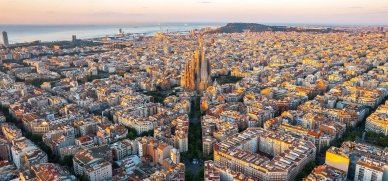
A bird's eye view of Barcelona
Petty theft is very convenient here because it is not punishable by Catalonian law. There might be just a preventive conversation at a police station. However, if a thief has accumulated a large number of accusations, fines can be imposed.
Filing any statements for the police is almost useless. A much better way is to keep an eye on the wallet, jewellery, and other items of value.
Seville
The Spanish tend to say that those who have not visited Seville have not seen a wonder. And they consider the city as one of the most charismatic in the country. It used to be a Roman colony that sprouted up on the site of the Phoenician settlement. Later it became a big port in the Mediterranean, and then - the centre of the Arab province of Išbīliya (إشبيلية; there is a belief that the name of the city has the Arabic origin).
The Golden Age in Seville took place during the colonization of North and South America - between the 15th and 17th centuries. Favourable location and established infrastructure made the city the main port in the Spanish Empire. It had a monopoly over the actively developing trade with West Indies, recently discovered by Christopher Columbus.
Seville was expanding fast due to many buildings like residential houses, shopping arcades, cathedrals, and palaces. Most of the current sightseeing attractions emerged during that period.
Nowadays, tourists fancy looking at curved and narrow streets of Casco Antiguo - a historical part of the city. The buildings there are so luxurious that resemble the palaces of the Roman emperors, where even the inner courts are marbled.
Seville is the city of fountains: beautiful waterfalls cascade down the sculptures and classical compositions.

Seville, Spain
The Cathedral of Saint Mary of the See, or Seville Cathedral, deserves special attention. It is a masterpiece of Gothic architecture of the 15th and 16th centuries and one of the largest Christian cathedrals in the world. Moreover, it is the world’s largest Gothic church.
Seville Cathedral is magnificent by itself, but the treasures kept there for centuries are of not less interest. Here you have a chance to see the paintings of great Spanish artists like Murillo, Goya, and Velázquez or to attend the Columbus Library that contains incunabula (the early printed books), Columbus’s manuscripts, and other ancient books.
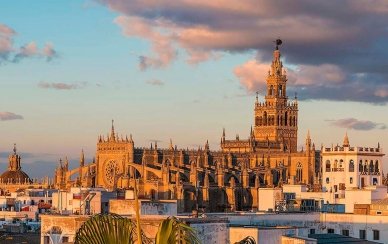
The Cathedral of Saint Mary of the See (Seville Cathedral)
The world-famous Spanish spectacle known as corrida originates from Seville too. The city’s bullring Maestranza (Plaza de toros de la Real Maestranza de Caballería de Sevilla) has a capacity of 14,000 viewers and is considered the most prestigious for matadors. The best time to feel the thrill and get the adrenaline going is from April to October.
The spectacles take place solely on Sundays. However, soft-hearted people had better not attend such a bloody and cruel performance. The local Bullfighting Museum enthralls with the splendid costumes of courageous matadors and portraits of the best toreros.
Alcázar of Seville is one more place that attracts tourists from all over the world. Alcázars are commonly referred to as fortresses. They are much similar to palaces built in the Iberian Peninsula between the 8th and 14th centuries during Muslim rule.
Alcázar of Seville emerged as fortification construction of the Arab Almohade caliphs. However, it was almost ruined later during the times of Reconquista. The Spanish architects constructed an entire palace complex on its site, which became the royal residence for the following centuries.
The palace and its premises are beautiful even now. They are renovated and well-maintained, so evoke much interest of the visitors to Spain. Moreover, cinematography has also become captivated by the locality. It became the site for some episodes of the cult television saga Game of Thrones.
Food
Spanish cuisine is so delicious, distinctive, and worth a separate gastronomic tour. Each region of the country has its specialties that define the cooking self of a locality:
- When in Andalusia in the time of its scorching heat, you will definitely be offered a bowl of a thick iced tomato soup called gazpacho.
- In Madrid during wintertime, nothing is better than a portion of the famous Madrid ragout. It consists of at least ten ingredients like several sausage varieties, bacon, meatballs, beans or chickpea, rice, cabbage, and onions. The constituents have to be stewed long with the addition of olive oil, herbs, and spices. The dish is served piping hot. You should discover this incredible taste!
- The Basque Country is famous for its exquisite cuisine despite the fiery and warlike temper of its residents. Only here will you be offered a mackerel stewed in a particular type of wine called Chakoli, specifically used for cooking meat, fish, and sauces. The wine is usually complemented with juicy Spanish tomatoes, onions, several spoons of olive oil, carrots, and pepper. And, the result is a tender gourmet fish.
- Navarre can surprise you with a lot of things, but its cooking traditions constitute something special. If you want to try the original Navarre lamb, you should definitely order a helping of the coal-roasted succulent and tender meat. And if to complement this with boiled, roasted, or stewed artichokes, widespread in this region, and a vegetable salad, then you will get a genuine Navarre dinner.
- The other food legend of Spain is paella valenciana. It is a hot dinner dish made of rice, chicken, fish, or seafood. The main ingredient of paella is saffron, which provides the rice with incredible yellow colour.
The distinctive feature of Spanish cuisine is garlic added to all dishes except perhaps desserts. It is an essential ingredient of the main and second courses, sauces, and salads; the amount varies by recipe.
The Spanish adore meat delicacies and have expert knowledge of them. Since ancient times, each region has had the original recipes of sausages and ham of every kind.
A peculiar thing in Spain is Jamón, dry-cured deboned pork. There are two types called jamón serrano (produced from white pigs) and jamón ibérico (made of the black Iberian pig). The latter is valued more and thus is very expensive. So it is a must to bring at least a little bit of jamón ibérico from this magnificent country.
Appetizers are one more necessary element of a Spanish banquet. Most of all, people fancy tapas and pinchos, which are the national variations of sandwiches and snacks.
The difference is not only in the names but in purpose too. Tapas are served in every bar and restaurant throughout Spain as a simple snack for alcohol like wine or beer. But pinchos are considered a whole appetizer.
Tapas are easy-to-cook sandwiches or plates full of nuts, slices of dry-cured sausage, or something else to eat immediately after a shot of drink.
Pinchos constitute a separate dish made of fried slices of baguette covered with pieces of fish, anchovies, shrimps, mussels, and other seafood varieties laid on lettuce or other green stuff, cucumber or tomatoes.
The other thing about how pinchos differ from tapas is the indispensable skewer used to spike the sandwich. And the name ‘pinchos’ originates from the Spanish language and means ‘spike’. What is more, tapas is a free snack whereas pinchos is not.

Even those who do not have a sweet tooth should try Spanish desserts. The exquisiteness of taste, unusual combinations of ingredients, and the ways of their cooking single out the Spanish sweet things among the others.
The visitors to the country are impressed with some distinct delicacies: crema catalana, or Catalan cream, is a delicious caramel souffle of Catalan origin; a delicate almond cream has its roots in the Canary Islands; yemas de Santa Teresa, or yolks of Saint Teresa, is a dessert made of yolks, cinnamon, sugar, and lemon juice.
Some of the sweet dishes are cooked only for some holidays. For example, on January 6, the Spanish celebrate Epiphany, also called the Three Kings’ Day, dedicated to three wise men that brought the baby Jesus the holy gifts. On this day, people bake roscón de reyes, or a yeast-dough king cake decorated with candied fruit and nuts.
The other holiday pastry is polvorón - crumbly shortbread with nuts - baked in every Spanish family for Christmas.
As a rule, beverages in Spain have two main aims: to lift spirits and to refresh. That is why the Spanish like coffee and refreshing juice- or wine-based drinks most of all.
Sangria and cider are the most popular. Sangria is usually a red wine with infused fruit wedges and spices and diluted with liquor and sparkling water.
Cider is Asturian apple wine. Serving cider in particular places called cidrerias has become a real show. Golden drink is poured from up high to flow directly into a glass. Moreover, wine should be flowing along the edge without any splashing. This overwhelming spectacle gathers crowds of viewers among the numerous tourists.
Spain is a magnificent country. It is hospitable and generous to its visitors but high-minded and imperturbable sticking to principles. With a gentle hand, it treasures everything obtained from ancestors and unshakeably builds its future, which is as beautiful as Spain itself.







